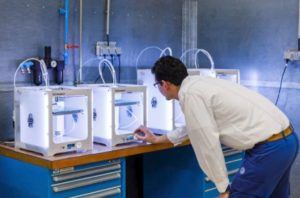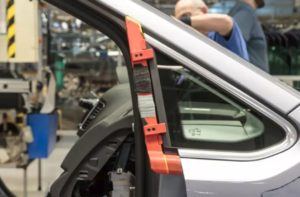Volkswagen: Additive Manufacturing as a Tool for Success

Can Volkswagen shake-up the status quo and use additive manufacturing to break into the tooling industry?
In any production line, identifying and addressing bottlenecks is pivotal in order to optimize output, employee utilization, and reduce overall production costs. For large corporations like Volkswagen, which produced roughly 11 million passenger and commercial vehicles globally in 2017, every second of a cycle time counts [1]. Given the maturity of their lines, operations have had to get creative in their means of optimization. Volkswagen Autoeuropa has identified one such solution in additive manufacturing.
Volkswagen Autoeuropa
Located in Palmela, Portugal, Volkswagen Autoeuropa was formed in 1991 as a joint venture between Ford Europe and Volkswagen Group. Since beginning operations in 1995, the assembly plant has produced parts for over 2.3 million vehicles [2]. On average, the plant (which employs nearly 4,000 people) processes 100,000 orders per year, including vehicle upgrades and VW’s Scirocco and Sharan range models [3].
Additive Manufacturing at VW Autoeuropa
Customized tooling, jigs, and fixtures are employed to effectively accomplish various tasks in the production line. These tools serve many purposes from properly aligning the liftgate badge to positioning the quarter window on the passenger doors. Traditionally, Volkswagen Autoeuropa relied on third-party manufacturers to design and supply them with manufacturing tools for every new run. The process typically followed the below format:
- Complete required paperwork to identify and contract third-party supplier.
- Work with supplier to develop initial design of tool.
- Receive and test prototype tool from supplier.
- Send part back to supplier with notes outlining required changes to optimize tool.
- Repeat trial-and-error approach.
With so many iterations and inefficiencies, purchasing and incorporating a new tool in a line is not only costly but also delays the production process [4]. Through utilizing in-house additive manufacturing to develop tools, Volkswagen Autoeuropa has eliminated the need to rely on outside suppliers and has drastically reduced the lead time between iterations.

Additive manufacturing is the process of joining materials to make objects from 3-D model data [5]. This proves to be a huge advantage over traditional manufacturing when dealing with customized parts as computer-aided design (CAD) software can be easily modified to incorporate lessons learned in practice. With this in mind, Volkswagen Autoeuropa has modified their process for developing tooling to the following:
- In-house production engineers and CAD technicians work to design tool.
- CAD models are sent to printers (which are located alongside the assembly line).
- Tools are printed overnight.
- Crew incorporates tools into production line the following day. Throughout the day, crew communicates areas for improvement to CAD technicians.
- CAD model is modified to address shortcomings and new tool design is sent to printers.
As can be seen, this “just in time” method of production allows for newly designed tools to be immediately tested. “Now we have way more tools, with better fit and for far less money. The timings and cost to produce tools led us to a fast ROI, better product quality, and satisfaction throughout the entire process – from development stages to the final product,” said Luis Pascoa, Pilot Plant manager at Volkswagen Autoeuropa [6].
Through the reductions in lead time, respective cycle times, and cost required for each tool, Volkswagen Autoeuropa has realized an estimated €200,000 in savings for 2017 [3]. One example is the production of a window gauged (shown below) used to position the rear window. Historically, the tool would cost €180 per part and take 8 days to complete. Through utilizing in-house 3D printing, the gauge can now be produced in 6 days at a cost of €35 per part [7].

Volkswagen’s Path Forward
As is the case for any product, additive manufacturing has its limitations. After purchasing the Ultimaker 2+ printer, Volkswagen Autoeuropa realized that they needed more capabilities including dual extrusion, which would allow them to produce parts with more complex geometries. They dealt with this issue by upgrading to the Ultimaker 3, the most capable printer offered by Ultimaker [8]. As an organization, Volkswagen should use the Autoeuropa group as an example and incorporate 3D printing at all production plants. If they are to do this, however, their printing requirements may exceed the capabilities offered by Ultimaker printers. To address the sustainability of additive manufacturing, Volkswagen should consider investing in a small 3D printing company. In doing so, they can have a say in the evolution of printers and ensure their needs are consistently met. Prior to committing to an action plan, Volkswagen must ask itself the following questions:
- Can Autoeuropa’s approach to producing tooling be implemented at larger sites, such as the Wolfsburg facility which has roughly 74,000 employees?
- If they were to acquire a small 3D printing company, how might Volkswagen incorporate them into the production process?
(Word count: 788)
References
1] “Volkswagen’s Worldwide Vehicle Production from 2006 to 2017”, [https://www.statista.com/statistics/272050/worldwide-vehicle-production-of-volkswagen-since-2006/], accessed November 2018
[2] “Volkswagen Autoeuropa Celebra 25 Anos”, [https://www.volkswagenautoeuropa.pt/comunicacao/relacoes-publicas/media-kit/press-releases/25-aniversario-volkswagen-autoeuropa.pdf], accessed November 2018
[3] Jackson, Beau “Volkswagen Saves $160k in Tooling Costs Using Desktop FDM 3D Printers”, 21 June 2017, [https://3dprintingindustry.com/news/volkswagen-saves-160k-tooling-costs-using-desktop-fdm-3d-printers-116640/], accessed November 2018
[4] “Volkswagen Autoeuropa 3D Prints Manufacturing Tools to Save Thousands of Euros”, 22 June 2017, [https://www.engineering.com/3DPrinting/3DPrintingArticles/ArticleID/14729/Volkswagen-Autoeuropa-3D-Prints-Manufacturing-Tools-to-Save-Thousands-of-Euros.aspx], accessed November 2018
[5] Choon Week Joel Lim, Kim Quy Le, Qingyang Lu, and Chee How Wong, “An Overview of 3D Printing in the Manufacturing, Aerospace, and Automotive Industries,” July/August 2016, [https://ieeexplore-ieee-org.ezp-prod1.hul.harvard.edu/stamp/stamp.jsp?tp=&arnumber=7517429&tag=1], accessed November 2018
[6] “Volkswagen Autoeuropa 3D Prints Manufacturing Tools to Save Thousands of Euros”, 22 June 2017, [https://www.engineering.com/3DPrinting/3DPrintingArticles/ArticleID/14729/Volkswagen-Autoeuropa-3D-Prints-Manufacturing-Tools-to-Save-Thousands-of-Euros.aspx], accessed November 2018
[7] “Volkswagen Autoeuropa 3D Prints Manufacturing Tools to Save Thousands of Euros”, 22 June 2017, [https://www.engineering.com/3DPrinting/3DPrintingArticles/ArticleID/14729/Volkswagen-Autoeuropa-3D-Prints-Manufacturing-Tools-to-Save-Thousands-of-Euros.aspx], accessed November 2018
[8] “Volkswagen Autoeuropa 3D Prints Manufacturing Tools to Save Thousands of Euros”, 22 June 2017, [https://www.engineering.com/3DPrinting/3DPrintingArticles/ArticleID/14729/Volkswagen-Autoeuropa-3D-Prints-Manufacturing-Tools-to-Save-Thousands-of-Euros.aspx], accessed November 2018



Your first question raises another interesting question about how innovation can scale in manufacturing and even in other large organizations. In this case, I do think it would be possible to implement this additive manufacturing process at a larger plant like Wolfsburg if the teams are specialized and autonomous. The crews and production engineers working on the tools should have enough expertise on their parts of the manufacturing process to drive innovation. If teams are rotating across the line, it will be difficult for them to learn and make improvements quickly. The teams also need to be autonomous so they can feel empowered to test, fail, and iterate. If they must submit each design change through a centralized management system, they will be less inclined to take risk and the process will slow down.
I agree that acquiring a firm to augment the capability already developed by Volkswagen Autoeuropa would be a good move to ensure the company stays ahead of the changes additive manufacturing will bring to the automotive industry. In terms of incorporating them in to the current production process I would suggest creating an Additive Manufacturing Center of Excellence to drive development and adoption of the technology within VW (and within VW’s supplier base where it makes sense). They can get started by doing break even analysis on current parts to establish a cost comparison of additive manufacturing vs traditional methods. One thing they’ll need to make sure is that they’re incorporating all of the relevant costs related to a conversion to additive manufacturing, “additional savings can be realized when inventory and logistics costs are taken into account, resulting in impacts throughout the supply chain…Parts can be printed just in time and/or via a PULL system which has a positive impact on inventory costs. Less transportation is needed since multiple parts of one product can be printed at once, eliminating the need for assembly, which positively impacts logistics costs.” [1].
Source:
[1] PricewaterhouseCoopers. “A Cost Perspective on 3D Printing.” PwC, http://www.pwc.be/en/news-publications/insights/2017/cost-perspective-3d-printing.html.
As a former Volkswagen of America employee, I agree with your recommendation that Volkswagen AG should extend its Autoeuropa capabilities to its Wolfsburg, and would go further to recommend that they expand to some of their North American and Chinese production facilities as well. Product variety and speed to market are the keys to success in the automotive space, particularly among volume brands like VW. Product life-cycles are longer than most – averaging 5 years, with a refresh in between- therefore, anything an OEM can do to shorten this life-cycle offers a competitive advantage. If 3D printing tools allows VW to be adaptive and nimble in its production, reduce costs, and increase volume, the technology is well-worth the investment.
I really like your recommendation that Volkswagen should buy a 3-D manufacturing company. It is an interesting proposal that squarely addresses the biggest concern with 3-D printing cost for auto giants, which is that a centralized, single auto-plant manufacturing company can erode Volkswagen’s competitive advantage, some of which stems from its intricate, global supply chain and relationships with vendors. Are automotive giants simply accelerating their own commoditization when they begin to mass-produce car parts with 3-D printing? https://www.cnn.com/2018/09/28/tech/volkswagen-3d-printing-parts/index.html
3-D printing is such an interesting topic. This article makes me want to ask so many different questions. The first one is 1) would there be a need for car companies if they are just using 3-D printing to manufacture cars? Subsequently, if there is a possibility to do so cheaply, then 2) why hasn’t this been done already? This second question actually makes me a bit angry. If there are ways to offer vital resources (cars, homes, etc) at really discounted prices by leveraging the benefits of 3-D printing, we should enact these new technologies as soon as possible.